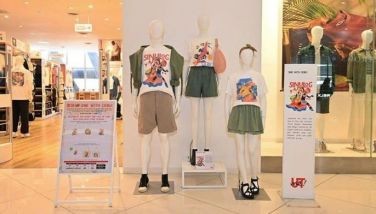Notes on Art basel HK
CEBU, Philippines — This was the strategy employed by Lilibeth Cuenca Rasmussen at the recent Art Basel Hong Kong, where her performance art piece, involving laying down for two hours at a stretch inside a claustrophobic coffin, was unveiled to the world. And sure enough, the following day, her ghoulish picture accompanied the feature piece by the New York Times, with a pithy caption describing her as a video and performance artist.
Sweet success! That was the assurance I gave Jun Villalon, proprietor of one of Manila’s premiere galleries, The Drawing Room. Villalon’s gallery had a prime spot at the fair, and over the years, it has featured Filipino artists and introduced them to a curious international art community. And that day, with only three photographs accompanying the Times feature, for his artiste to be included among those three photos was a sure mark of success.
For there are now hundreds of galleries from 32 countries and territories showing at Art Basel, featuring thousands of artists, whether masters, mid-career and emerging, spanning all styles and pleasing all sensibilities. The sheer variety found at the fair and the gargantuan enormity of it all would be almost enough to intimidate any gallerist, much less an artist.
There in that snooty booth can be seen a Picasso, and over there, in a hushed corner, a Basquiat. Willem de Kooning’s 1975 work reportedly sold for US$35 million. Video installations from Chinese contemporary artists beam neon watts. An ethereal, perpetually floating Japanese cloth enthralls the audience. With the artistic talent of Asia and beyond on full display, competing for attention, buyers, press, and buzz, who wouldn’t think one’s work would simply get swallowed up in the cacophony?
But good art will always find a way to strike a chord. And regardless of how vast a show is, standouts will always show up and manifest.
To be sure, the quality of artworks was impressive. (And so were the price ranges). Japanese artist Katsura Funikoshi’s ensemble of caricaturized sculptures and black-and-white sketches was striking. (One is reminded of Filipino artist Riel Jaramillo Hilario). American Mark Ryden showed exquisite doll-like portraits (and local big-eyed waif figurative painters Rene Cuvos and Ma-yi Penaflorida comes to mind). I was not familiar with German visual artist Norbert Bisky, but after a first encounter, where I thought I was imagining homoerotic undertones (and apparently I wasn’t), I became an instant fan.
As well, for the first time, more than a handful of Taiwanese galleries participated and stamped their mark upon the international art community, impressing collectors with the breadth of local talent. Taiwanese talent surely held their own.
Of course, there were a few questionable works that evoked more controversy than fans. For some reason, trashcans with various items of detritus were popular as statement pieces by conceptual artists. The best one had plastic water bottles all lit up inside a supermarket trolley. But another bin had cheap soda cans, and yet another had gaudy golden shreds of wrapping paper. What was the point of them all? Who knew? But if there was a gullible art lover willing to pay top dollar for it, he was very welcome to it.
As if the world’s political chaos had infected the brains of starving artists, still others presented strips of tattered cloth, or medicine cabinets, or even broken pottery, as art pieces worthy of adoration
Sigh. Fortunately, there were many favorites able to spirit one’s mind off of the Marcel Ducghamp wanna-bes, such as Yoshitomo Nara, with a delightful schoolgirl clambering up a ladder, her dainty red shoes left at its foot. Jim Dine offered an interesting installation piece of enormous graffitied jars stuck with metalluc found objects like steel wrenches. Ivan Navarro packaged together beams of light pouring from drums. And so many more.
It would be impossible to be an art lover and not fall in love with even a single artwork from the hundreds of thousands available at the massive HK Convention Center. Art Basel’s premise almost makes this a certainty. And as usual, the tickets were sold out early, and lines stretching to several blocks greeted art lovers. But it was all worth it. All three days, and thousands and thousands of steps of it.
At least, there’s a year to recover.
- Latest


























